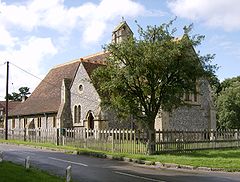Ashley Green
| Ashley Green | |
|---|---|
 St John the Evangelist parish church |
|
| Ashley Green shown within Buckinghamshire | |
| Population | 980 (2011 Census including Orchard Leigh) |
| OS grid reference | SP9705 |
| Civil parish |
|
| District | |
| Shire county | |
| Region | |
| Country | England |
| Sovereign state | United Kingdom |
| Post town | Chesham |
| Postcode district | HP5 |
| Dialling code | 01442 |
| Police | Thames Valley |
| Fire | Buckinghamshire |
| Ambulance | South Central |
| EU Parliament | South East England |
Ashley Green is a village and civil parish in Chiltern district of Buckinghamshire, England. The parish is on the boundary with Hertfordshire, midway between Chesham and Berkhamsted.
Originally a hamlet within Chesham parish, its toponym is derived from the Old English for Ash Field, referring to the forest that once covered this part of the Chiltern Hills.
Ashley Green used to have a Baptist church, situated down Hog Lane, which was a branch of Broadway Baptist Church in Chesham. It closed in the early 1900s.
Anglican services started in the village school in 1872, led by Rev Pratt, vicar of St Mary's Chesham. Land for an Anglican church was given by Lord Chesham. The architect was G.E. Street and the contractor G. Cooper of Aylesbury Buckinghamshire. The total cost of the building was over £2,000 with the endowment being a further £6,000. The Church was built and endowed by the gift of Elizabeth Dorrien of Clifton, Bristol, in memory of her sisters and dedicated to John the Evangelist on 31 December 1873, although it was already in use when it was dedicated. Ashley Green became a separate ecclesiastical parish in 1876. Newspapers and coins were built into the pillar adjoining the pulpit. In 1980 the parish rejoined Chesham parish under a team ministry.
The Church is built of local knapped black flints with Bath stone dressings. There is a bellcote with two bells. There is a boiler house, and the church was originally being heated by "Hayden's hot air apparatus", now disused. The porch is on the Northern side of the building the front of which is an oak moulded archway, the timber being framed in red bricks - herringboned. The roof is of plain clay tiles. St. John's has stained glass windows from various makers including Burlison and Grylls, Kempe and Co., James Powell and Sons, C.E. Moore and A.L. Moore.
...
Wikipedia

